Thanks to the competent choice of wallpaper for the room, designers achieve the creation of an interior background of the premises that is stunning in its beauty. But contrary to popular belief, experts choose wallpaper for decorating a room not for reasons of saving money. Certain types of wallpaper can surpass wall coverings such as decorative plaster, intricate graffiti and even wall tiles for a price per meter.
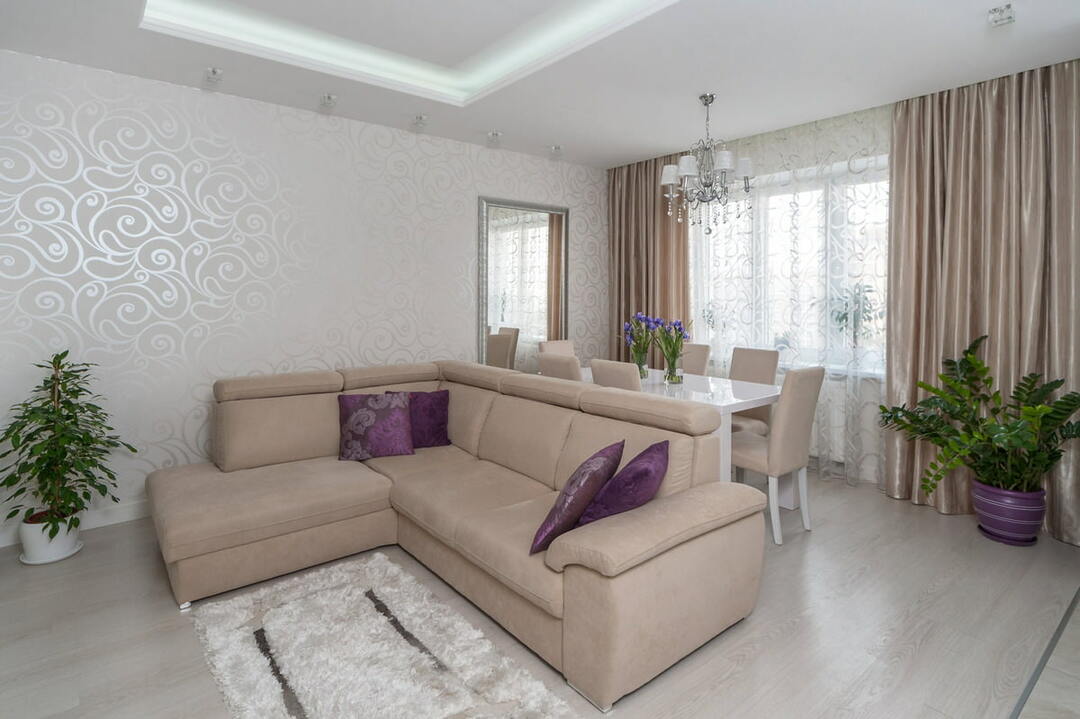
Among the huge selection of colors and textures of wallpaper, you can find exactly what will reflect the tastes of the owners of the house and fit perfectly into the interior design
In their decision to use wallpaper as the main background covering for walls and ceilings, designers are guided by the following principles:
- Wallpaper is easier to install and remove than other types of coverings. Wallpapering does not require any special skills and does not take much time.
- A section of wallpaper damaged during installation or use is easy to replace. When plaster peels, tiles collapse, or paint fades, it takes time-consuming work to bring the aesthetics back to the room. In case of damage or fading of the wallpaper, you can simply replace the strip with the damaged area.
- The wallpaper is safe and environmentally friendly.
Types of wallpaper
Content
- Types of wallpaper
- Vinyl
- Paper
- Non-woven
- Wallpaper colors
- Room with green wallpaper
- Room with blue wallpaper
- Room with red wallpaper
- Combination options with painted walls
- Video: Rules for combining wallpaper in the interior
- Photos of room design ideas with wallpaper
- In the bedroom
- On the kitchen
- In the nursery
- In the living room
In order to determine which wallpaper is best for a room, you must first determine which of their types is most suitable for various room parameters. For example, kitchen wallpaper is constantly exposed to changes in ambient temperature and attacks from humid air and steam. Wallpaper in a living room with wide windows must be resistant to sunlight. The hallway is famous for its increased level of wall pollution. This is explained by the fact that particles of dirt and dust brought from the street are shaken off when undressing directly on the walls and on the floor.
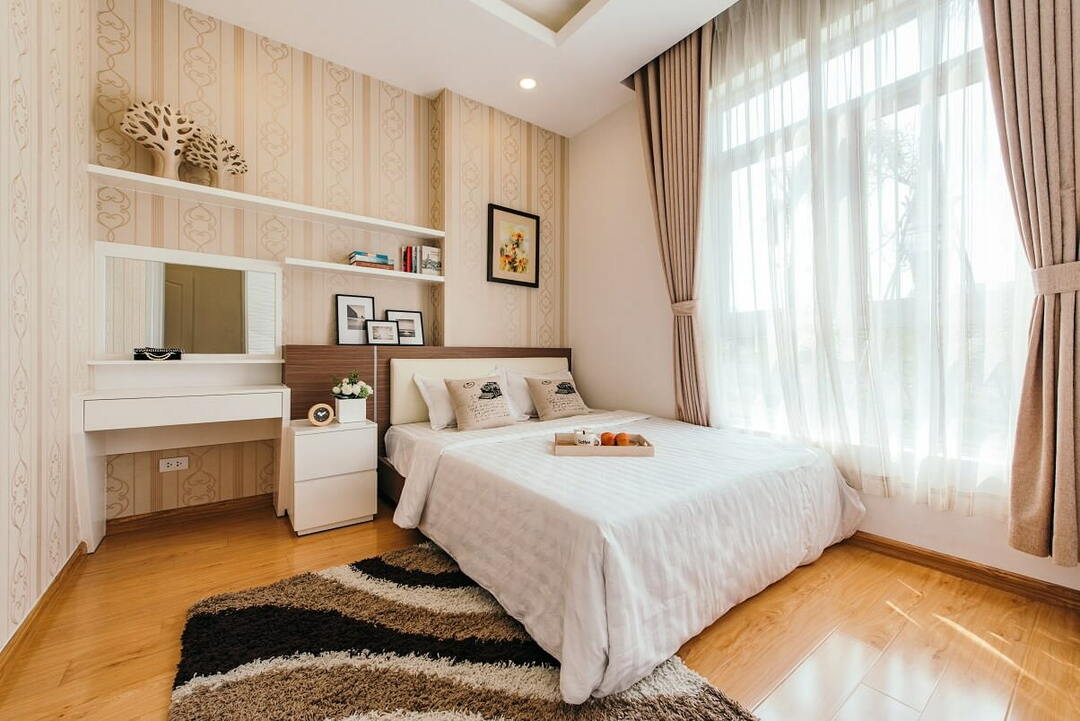
Each type of wallpaper has its own distinctive features and different characteristics.
Therefore, before choosing wallpaper for a room, you should carefully study their varieties and properties. Modern technology has spawned a huge number of different varieties of wallpaper, from expensive to very cheap. Below are the three most popular types present on the construction markets of the Russian Federation.
Vinyl
Vinyl in the structure of such wallpaper acts as an upper moisture-resistant material connected to the lower base. Vinyl itself is a very comfortable material. It is resistant to direct sunlight, withstands temperature extremes and allows wet cleaning on vinyl surfaces.

Vinyl wallpaper with a bright print in the hallway
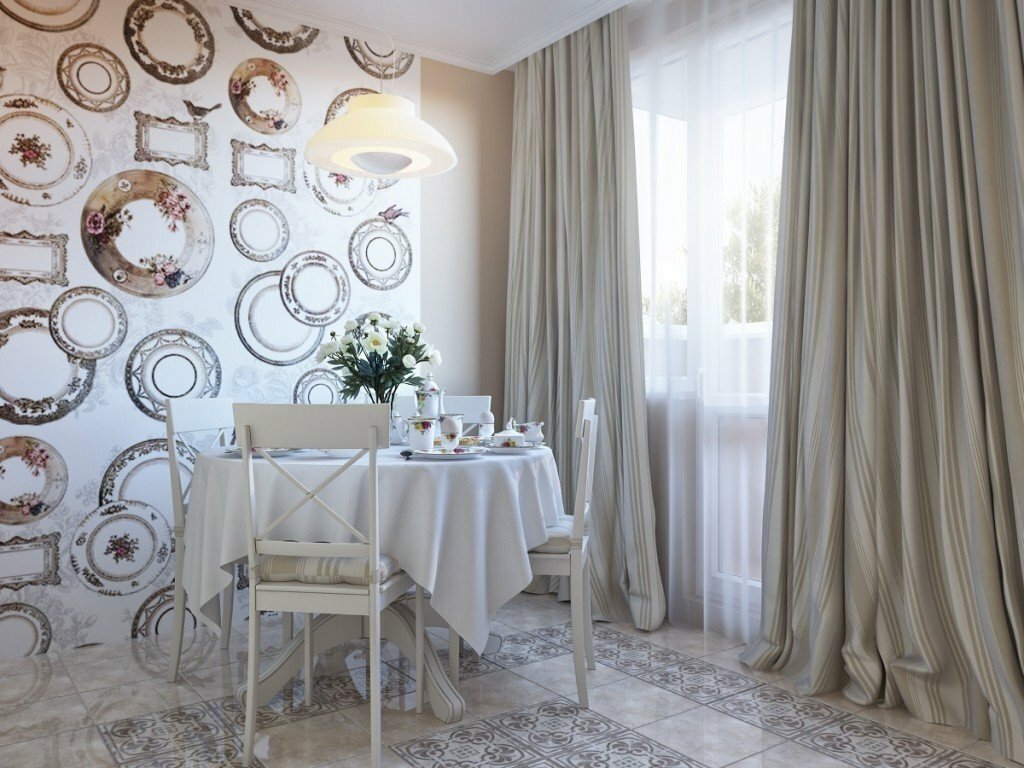
Spacious kitchen with washable vinyl wallpaper on accent wall
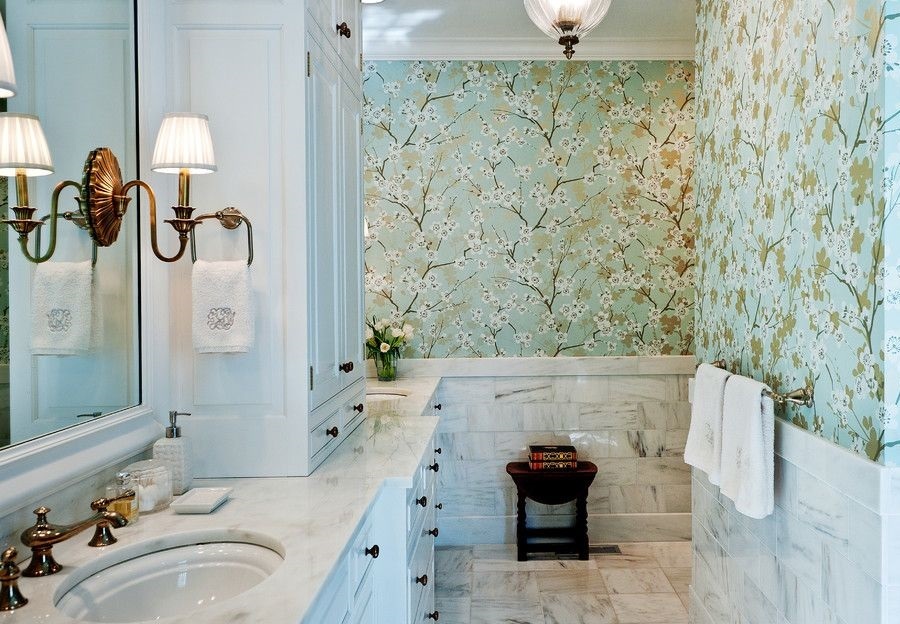
Non-woven vinyl wallpaper in the bathroom of a country house
But, unfortunately, vinyl does not have the required properties for adhesion to walls and ceilings. To overcome this circumstance, vinyl is pre-bonded with a base (paper, non-woven) more suitable for gluing. The result is a useful combination of two layers, which, due to their density and relief, acquire another useful property - they are able to well mask irregularities on the wall (bumps, cracks, nail marks, holes after drilling etc.).
Vinyl wallpaper is recommended for kitchen, hallway and balcony decoration.
Paper
Paper wallpapers are the most economical, safe and easy to install. But at the same time, they are also the most short-lived (several years), the most fading, the most unstable to moisture, temperature changes, etc. Truth, in defense of this type of product, you can add their one more positive property: single-layer paper wallpaper passes air and particles well through itself pair. This allows you to dry damp walls without dismantling the paper covering. However, breathability is greatly reduced in multi-layer types of paper wallpapers. And although such products tolerate dampness of walls worse, the multilayer technology allows them to significantly increase their protective qualities.
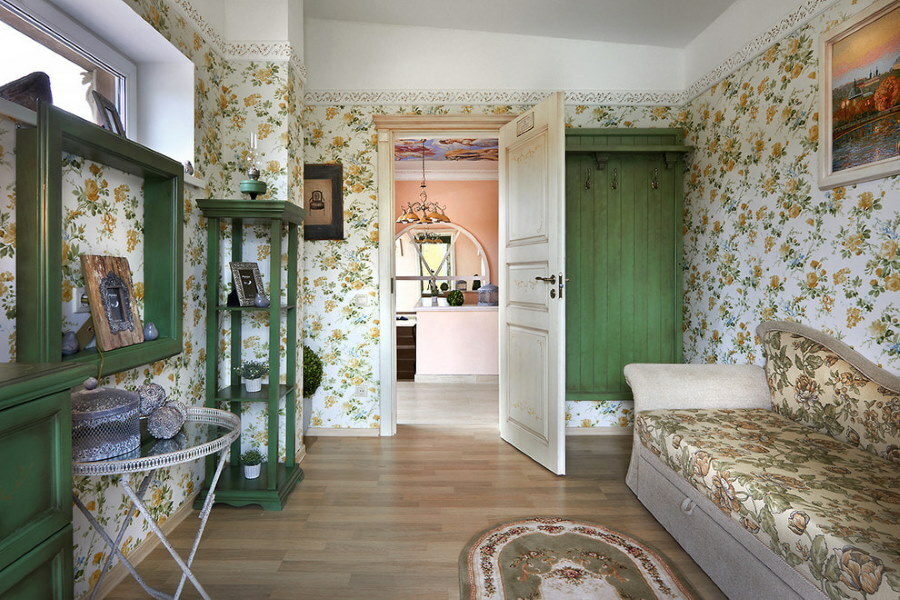
Paper wallpaper with a discreet floral pattern in a Provencal style room
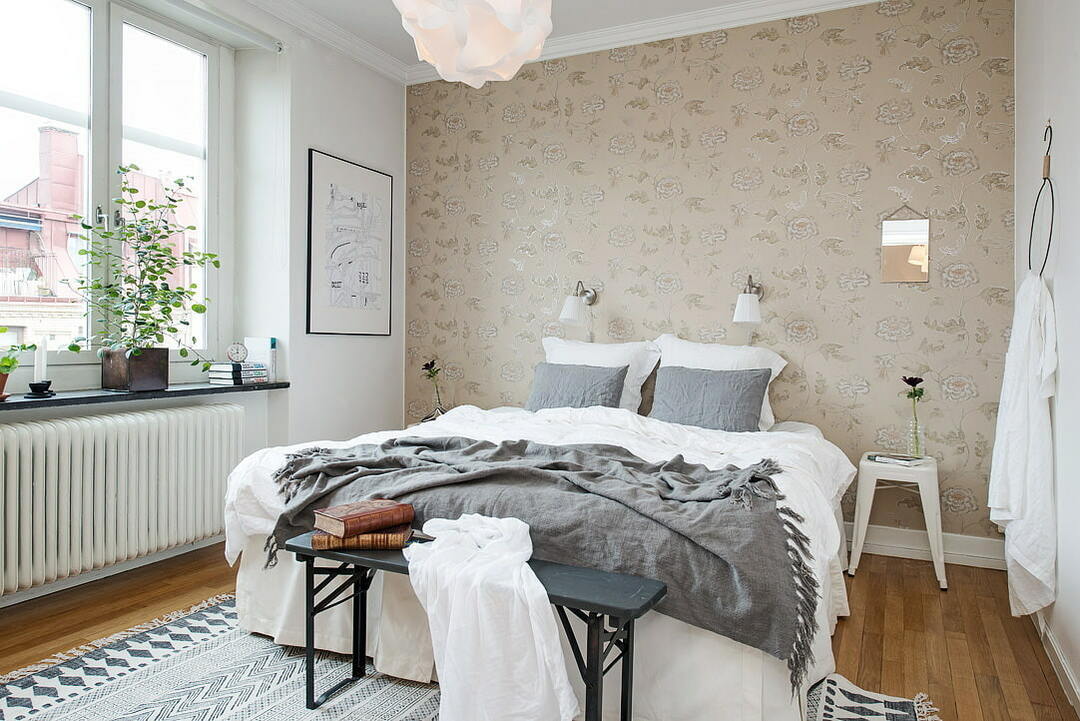
Pastel wallpaper on a paper base in a Scandinavian-style bedroom
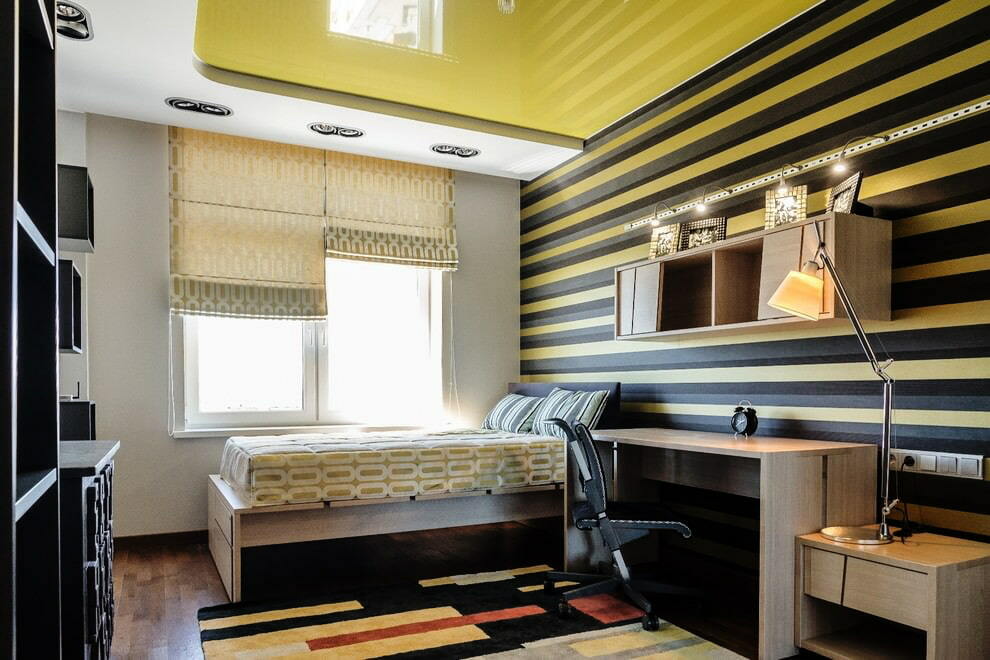
Paper wallpaper with horizontal stripes in a teenager's room
By the number of layers, the types of paper coatings are usually divided into:
- simplices (one layer of paper);
- duplexes (two layers);
- triplexes (three layers).
It is preferable to decorate rooms on the north side of the house with paper wallpaper. The weakness of sunlight and susceptibility to dampness of the walls will allow the most rational use of their positive properties.
Non-woven
The desire to add the properties of vinyl to breathable paper wallpapers has led to the development of a composite fiber material called interlining. As a result, the developers received an average version of the qualities of a new type of wallpaper. Non-woven products have almost the same vapor permeability as paper ones, but at the same time they tolerate wet cleaning better.

Non-woven wallpaper in the interior of a neoclassical kitchen
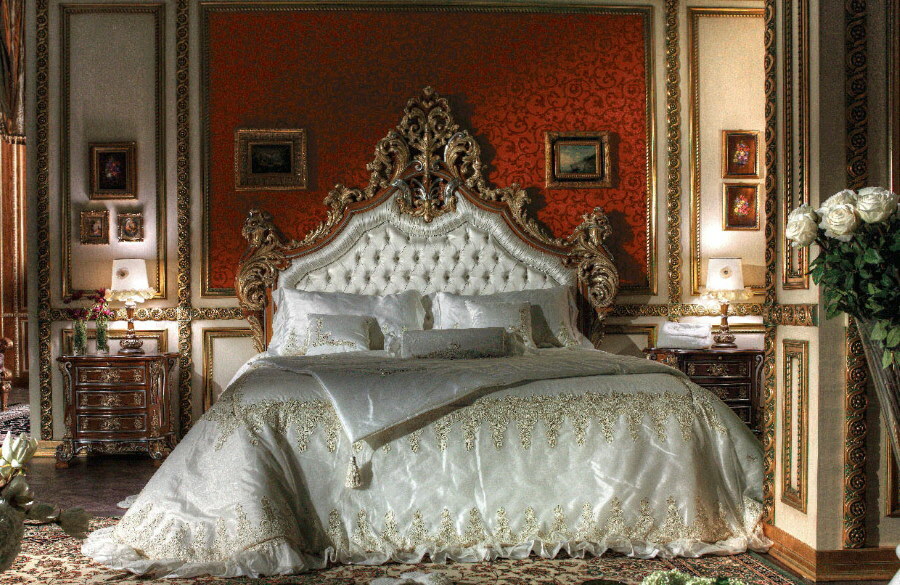
Luxurious baroque bedroom with expensive non-woven wallpaper
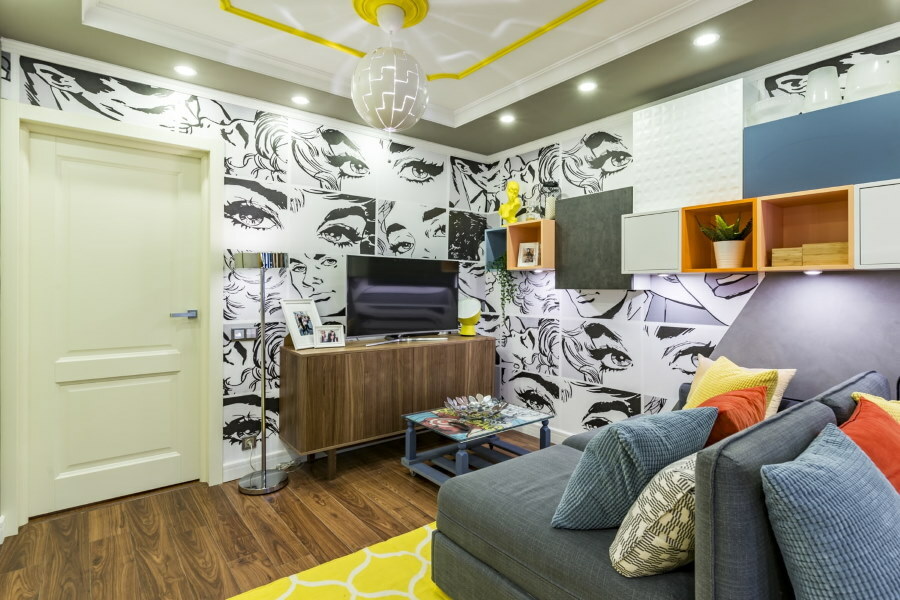
Pop art youth room decorated with playful non-woven wallpaper
Wallpaper colors
When choosing wallpaper for a room, the color and tone of the future wall or ceiling covering is of no small importance. Wall coverings should correspond to the style in which the general interior of the room is made.
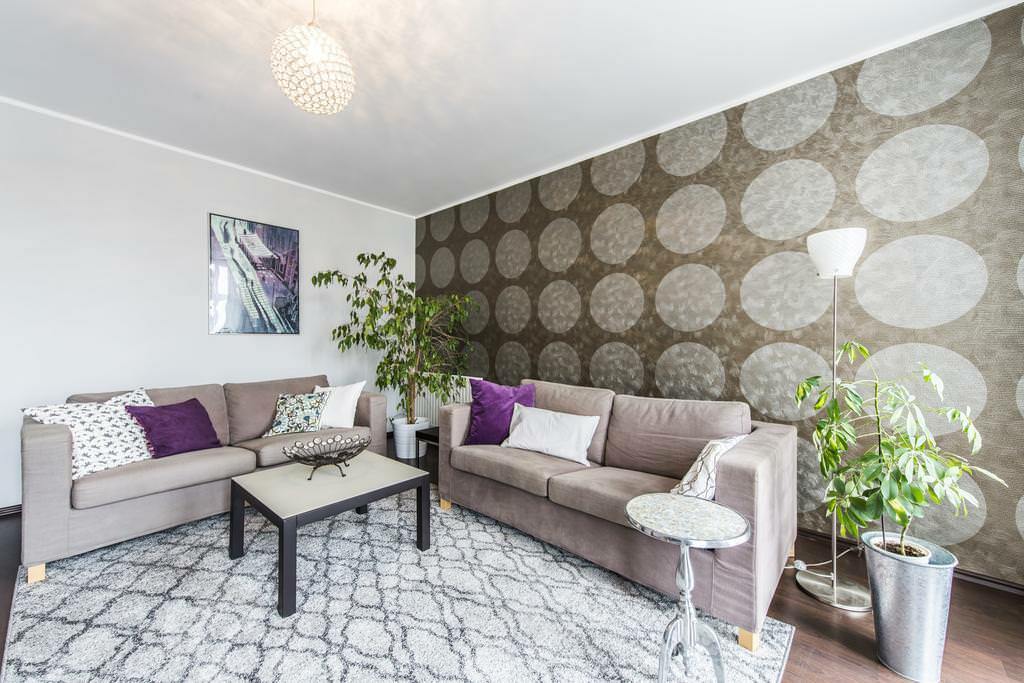
With the color of the wallpaper, you can create a variety of interior effects

In addition to color, the texture displayed on the wallpaper is also important.
The principle of the obligatory presence of three colors (blue, green and red) in a room is a rather controversial postulate among designers. But other principles of color combination are not in doubt. The most important ones are the following:
- Warm and cold tones should not be mixed. Psychologists have proven the unfavorable effect of the simultaneous contemplation of colors at different temperatures.
- It is important to be able to distinguish between the different-sex properties of colors and tones. Most often, these properties are used to decorate a children's room. Growing up girls should be surrounded by soft, gentle and warm colors. Boys, on the other hand, are best raised against a background of stricter, colder and harsher tones. It is in the childhood period of the formation of the personality in a person that the masculinity or femininity of his character is laid. And the color background surrounding a small child not least of all influences his subsequent perception of the world and behavior.
- The color of wallpaper and laminate flooring must not match. The difference in the color spectrum of the background of the wallpaper and the laminate must be at least three tones. When decorating monochromatic styles, it is necessary to separate the floor and walls with contrasting skirting boards.
- The overall color of the wallpaper and curtains should differ by at least a few tones.
- In the bedroom, wallpaper should be in soothing shades. It is forbidden to decorate the resting places with stimulating tones or wallpaper with aggressive patterns.
Room with green wallpaper
Green is considered a natural, harmonious color that evokes associations with spring and the anticipation of summer abundance. Subconsciously, a person perceives the green background as the end of winter (a difficult period) and the expectation of summer (a favorable period). This color is able to soothe anxiety, give hope and even get out of depression.
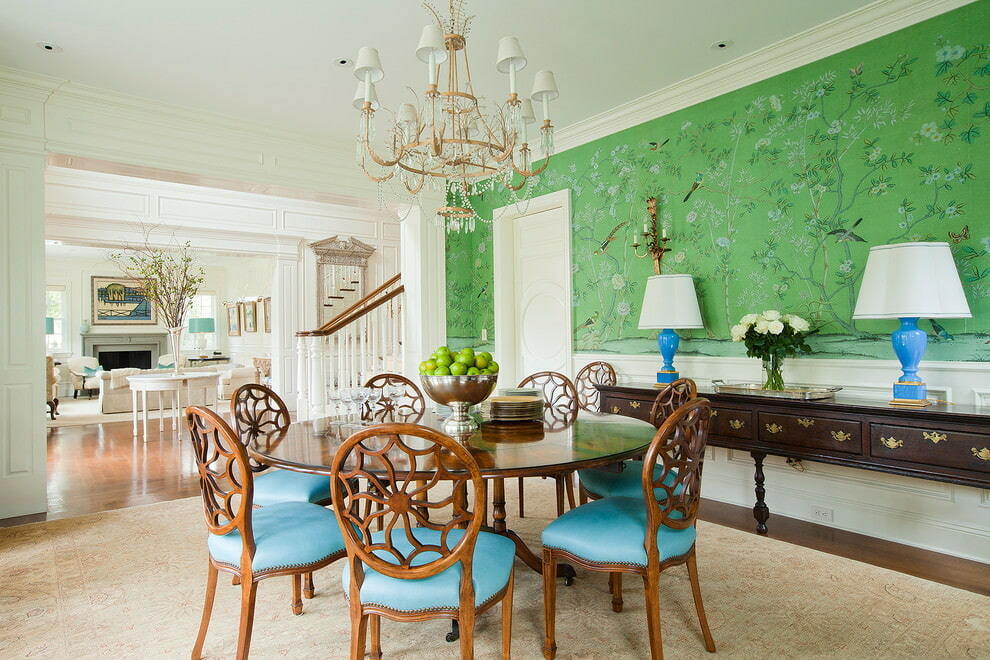
Green wallpaper with plant patterns is suitable for the living room or bedroom
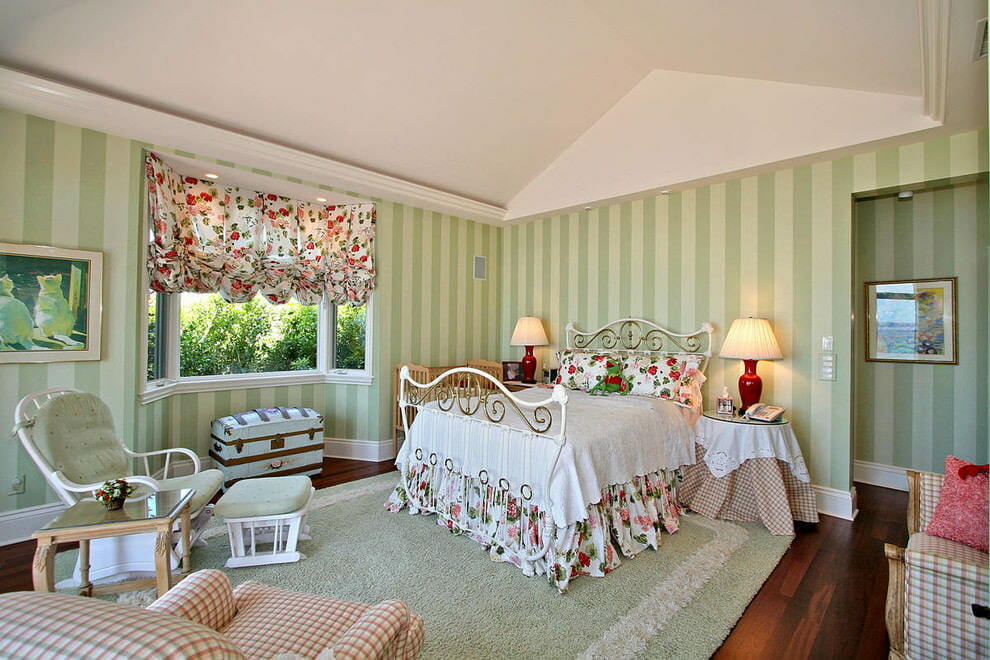
Green striped wallpaper allows you to change the visual perception of the space of the room
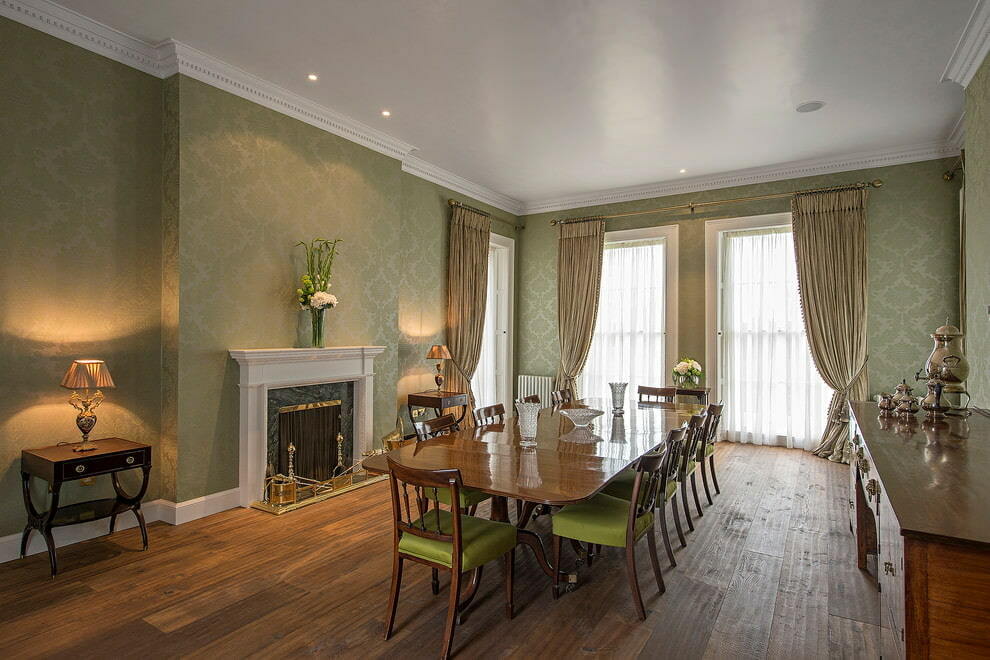
Dark green wallpaper with curls or monograms is most often found in classic interiors.
Green is considered neutral, but psychologists warn against adding large amounts of red or blue to the green background. This color combination is rather controversial, because each of the three basic colors has its own clear association and reaction in the subconscious of a person. Color perception can use a mechanism of constant emotional switching, which even gives some people a certain drive. But in the long term, this can cause a repulsive effect in someone from the household and the wallpaper will have to be changed.
Room with blue wallpaper
The basic blue color most people associate with twilight. After sunset, the sky changes from blue to dark blue. The changing background signals the subconscious mind that night is approaching. Light shades of blue wallpaper disposes to communication, philosophy and creative work. Light blue wallpaper relaxes the body a little, but at the same time stimulates the brain. A similar shade is good for wallpaper in a study or in a business meeting room.

Plain blue wallpaper will decorate the bedroom interior in the style of minimalism

A floral print on a blue background will emphasize the stylistic design of the room
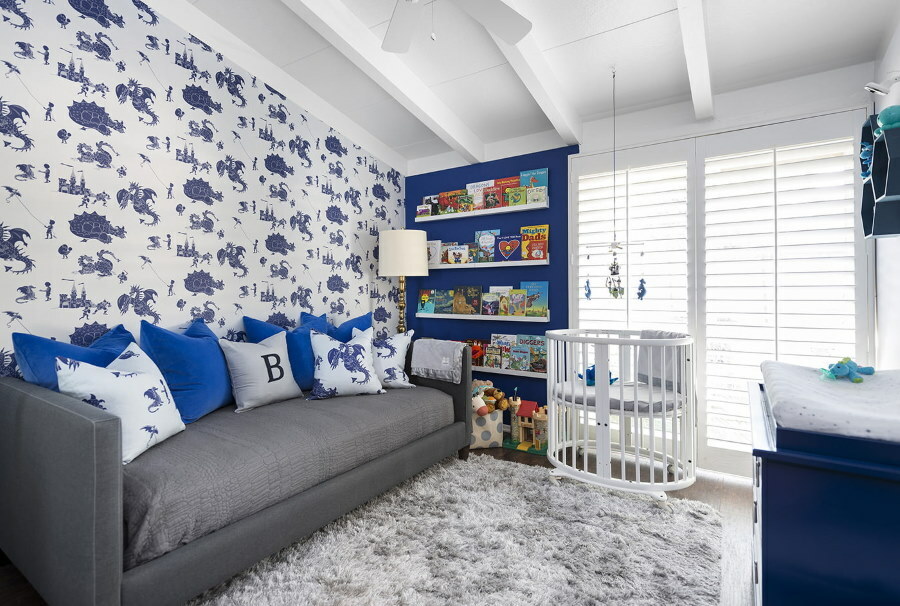
Light wallpaper with blue patterns is perfect for decorating a boy's room
The darker tones of blue cause laziness and reluctance to do labor-intensive work. The darker the blue background, the more the subconscious mind signals the approach of night. Often such shades have a depressing effect on a person. And gray on a dark blue background can make a person feel melancholy.
Room with red wallpaper
Red is a symbol of fire and warm summer. It stimulates action, improves tone, attracts, energizes and warms. However, such color dope in the form of red wallpaper gives its maximum effect only for a certain time. Passive and withdrawn people can stimulate their activity with a red background for hours. A room with red wallpaper will very quickly provoke emotional people to decisive actions. And if this energy does not find a constructive outlet, it will introduce a psychologically active person into a state of irritability and aggression.
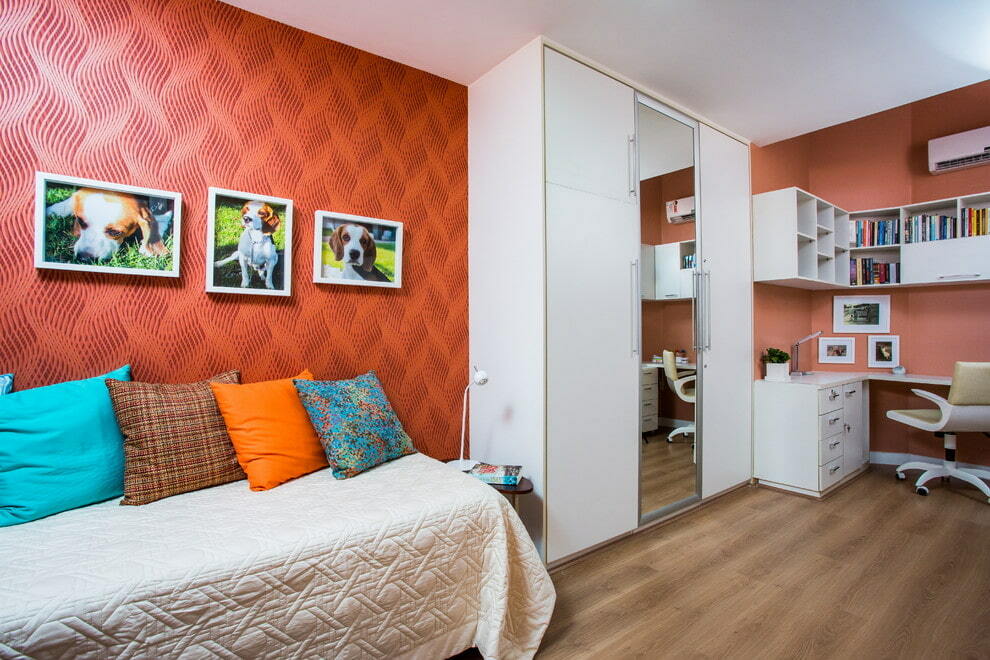
The use of red tones in the interior of the room should be dosed.
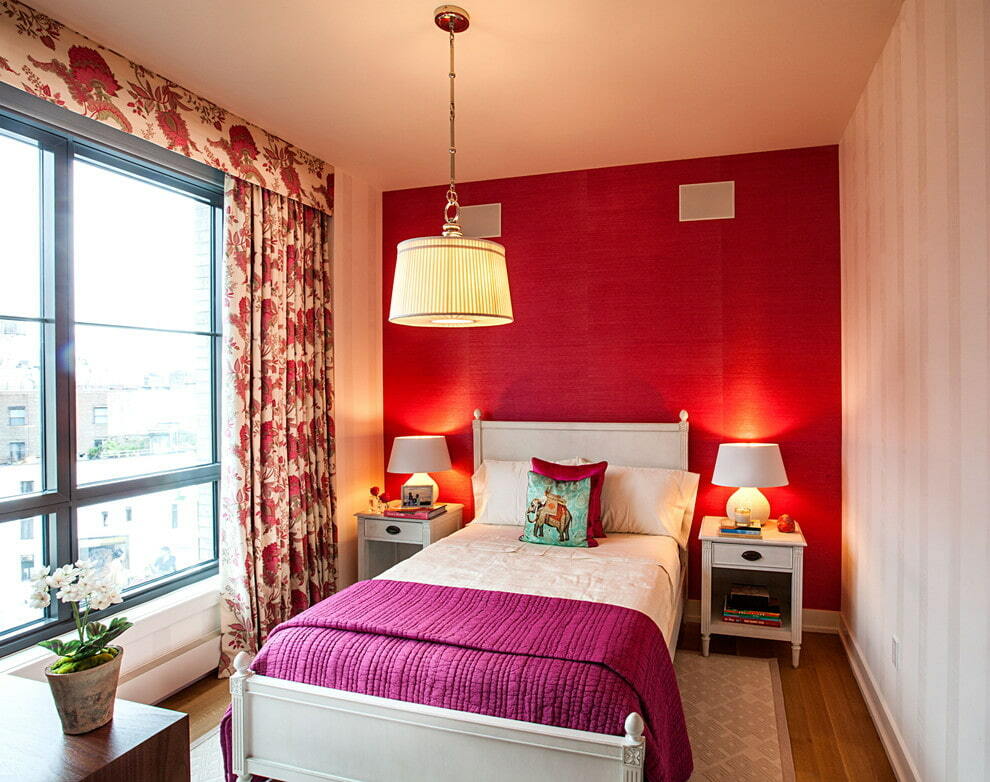
Solid red wallpaper is suitable for decorating an accent wall in a bedroom
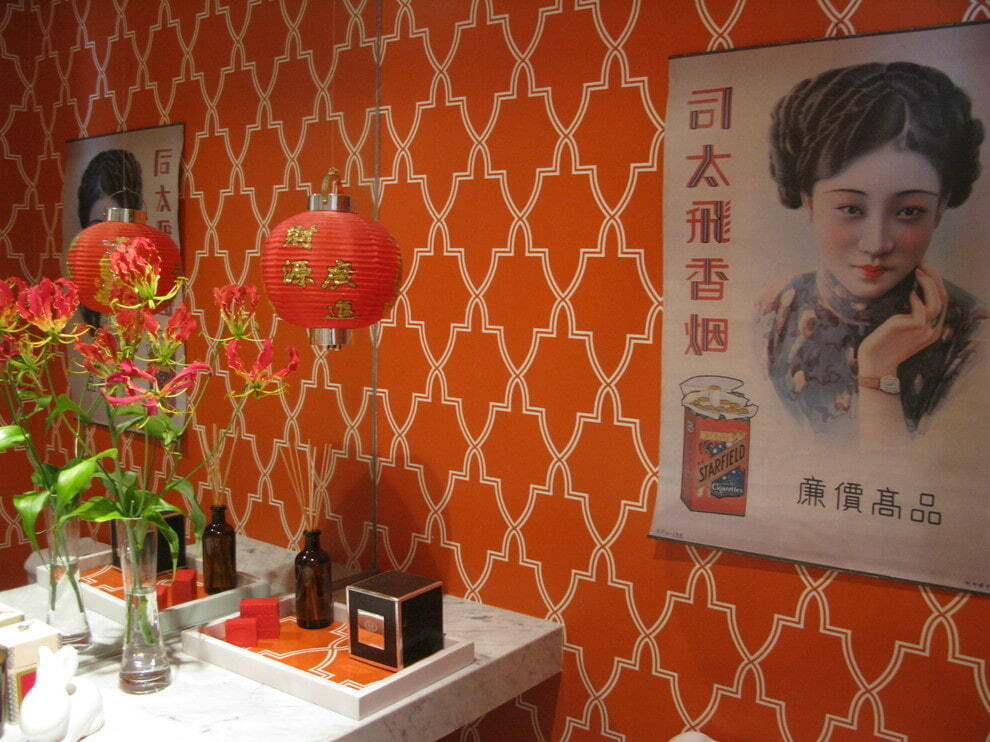
Wallpaper ornament should reflect the style and character of the room.
Light red tones of the wallpaper (closer to pink) are well suited for a girl's children's room, bringing up moderate emotionality in her from childhood. But dark red wallpaper is generally not recommended to be installed in living rooms.
Combination options with painted walls
The combination of painted walls and wallpaper in the design of rooms is formed based on the general rules for the design of background interior elements. Of the most important principles for the combined design of an apartment, the following can be distinguished:
- The color of the painted surface and the wallpaper must not match.
- If the painted surface and the wallpaper delimit the wall into two parts, then it is necessary to come up with a transitional element on their border. It can be a decorative element or tall furniture. A transition is also necessary if the wallpapered wall is adjacent to the painted wall.
- Thin wallpapers applied over painted walls may change their hue due to the optical alignment of wallpaper and paint colors.
- You can use wallpaper with slots, in which the painted surface of the wall acts as an element of the wallpaper pattern.
Each owner decides for himself which wallpaper is more convenient for him to choose for finishing a living room. And the individual taste of a person does not always coincide with the established design rules and advice of psychologists.
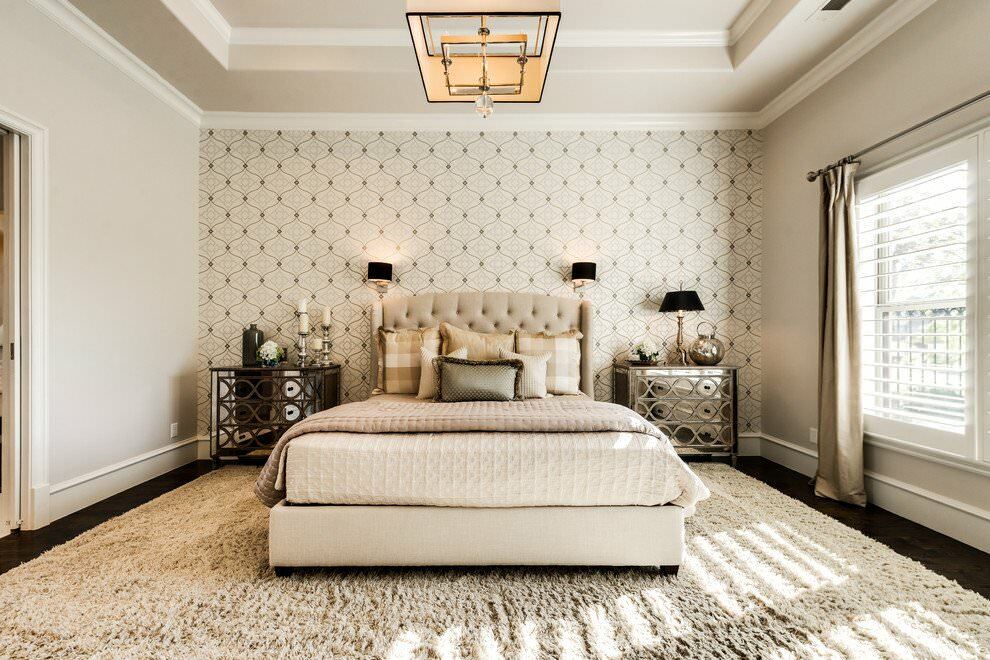
Light beige wallpaper combined with plain walls in the bedroom

Bright red checked wallpaper, matched to contrast with the rest of the room
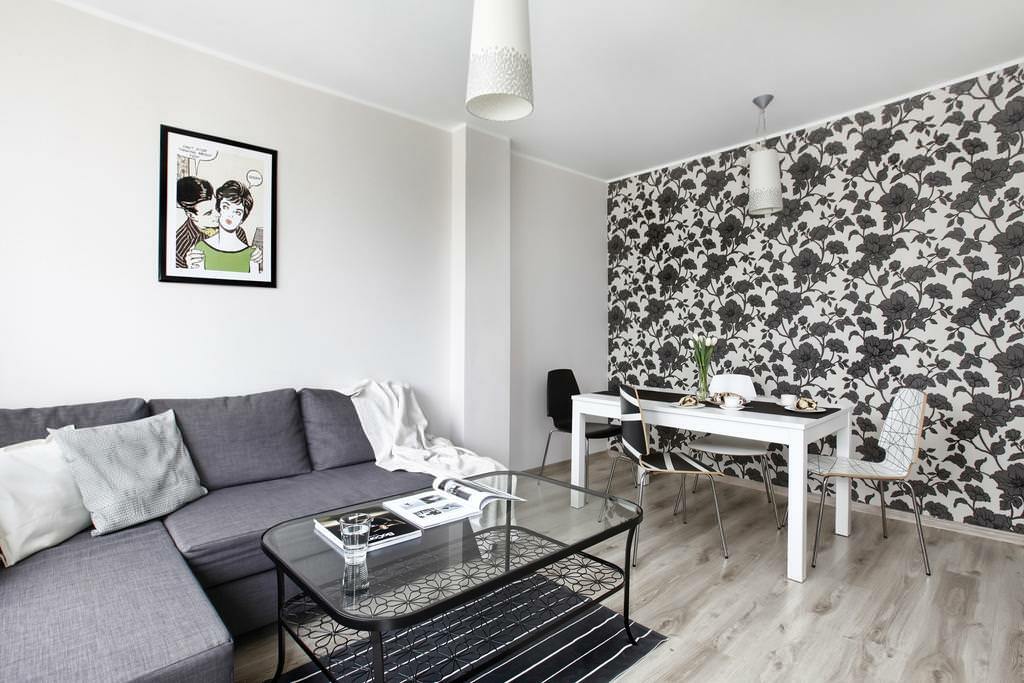
Gray and white wallpaper in a modern-style blacksmith-living room
